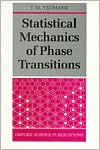

 |

|

Sold Out
Book Categories |
| 1 | Introduction | 1 |
| 1.1 | Phase transitions in other systems | 4 |
| 1.1.1 | A ferrimagnet: cerium antimonide | 4 |
| 1.1.2 | Surfactants in solution | 7 |
| 1.2 | A microscopic model | 8 |
| 1.2.1 | A renormalization group | 13 |
| 2 | Statistical mechanics and thermodynamics | 15 |
| 2.1 | Statistical mechanics | 15 |
| 2.2 | Thermodynamics | 16 |
| 2.3 | Convexity properties of the free energy | 19 |
| 2.4 | Correlation functions | 20 |
| 2.5 | First-order and continuous phase transitions | 21 |
| 2.6 | Critical point exponents | 25 |
| 2.6.1 | Universality | 27 |
| 2.6.2 | Exponent inequalities | 29 |
| 2.7 | Problems | 30 |
| 3 | Models | 33 |
| 3.1 | The spin-1/2 Ising model | 35 |
| 3.1.1 | Order-disorder transitions in binary alloys | 36 |
| 3.1.2 | Lattice gas models | 39 |
| 3.2 | The spin-I Ising model | 41 |
| 3.3 | The q-state Potts model | 41 |
| 3.4 | X-Y and Heisenberg models | 43 |
| 3.5 | Universality revisited | 45 |
| 3.6 | Discussion | 47 |
| 3.7 | Problems | 48 |
| 4 | Mean-field theories | 50 |
| 4.1 | Mean-field theory for the Ising model | 50 |
| 4.1.1 | Mean-field critical exponents | 53 |
| 4.2 | Landau theory | 54 |
| 4.2.1 | Mean-field critical exponents revisited | 56 |
| 4.3 | The correlation function | 57 |
| 4.4 | Classical mean-field theories | 59 |
| 4.4.1 | Van der Waals theory of fluids | 60 |
| 4.4.2 | Weiss theory of magnetism | 61 |
| 4.5 | The validity of mean-field theory | 61 |
| 4.6 | Problems | 63 |
| 5 | The transfer matrix | 67 |
| 5.1 | Setting up the transfer matrix | 67 |
| 5.2 | The free energy | 69 |
| 5.3 | The correlation function | 70 |
| 5.4 | Results for the Ising model | 72 |
| 5.4.1 | The free energy | 73 |
| 5.4.2 | The magnetization | 73 |
| 5.4.3 | The correlation function | 73 |
| 5.4.4 | The correlation length | 74 |
| 5.5 | Problems | 74 |
| 6 | Series expansions | 79 |
| 6.1 | High temperature series expansions | 80 |
| 6.2 | Low temperature series expansions | 85 |
| 6.3 | The one-dimensional Ising model | 86 |
| 6.4 | Analysis of series expansions | 88 |
| 6.5 | Problems | 92 |
| 7 | Monte Carlo simulations | 95 |
| 7.1 | Importance sampling | 95 |
| 7.2 | Practical details | 97 |
| 7.3 | Considerations in the data analysis | 100 |
| 7.3.1 | Influence of the starting configuration | 100 |
| 7.3.2 | Statistical errors | 101 |
| 7.3.3 | Finite-size corrections | 102 |
| 7.4 | Examples | 102 |
| 7.4.1 | The three-dimensional Ising model | 102 |
| 7.4.2 | More complicated systems | 103 |
| 7.5 | Problem | 104 |
| 8 | The renormalization group | 105 |
| 8.1 | Definition of a renormalization group transformation | 106 |
| 8.2 | Flows in parameter space | 108 |
| 8.3 | Universality | 112 |
| 8.3.1 | Crossover | 112 |
| 8.4 | An example | 113 |
| 8.5 | Scaling and critical exponents | 115 |
| 8.6 | Scaled variables | 118 |
| 8.7 | Conformal invariance | 120 |
| 8.8 | Problems | 121 |
| 9 | Implementations of the renormalization group | 124 |
| 9.1 | The one-dimensional Ising model | 124 |
| 9.1.1 | Derivation of the recursion equations | 125 |
| 9.1.2 | Fixed points | 127 |
| 9.1.3 | Fixed points and scaling | 129 |
| 9.1.4 | The free energy | 130 |
| 9.2 | Higher dimensions | 132 |
| 9.3 | The q-state Potts model | 136 |
| 9.4 | The Monte Carlo renormalization group | 139 |
| 9.5 | The [epsilon]-expansion | 140 |
| 9.6 | Problems | 141 |
| Further reading | 145 | |
| Index | 147 |
Login|Complaints|Blog|Games|Digital Media|Souls|Obituary|Contact Us|FAQ
CAN'T FIND WHAT YOU'RE LOOKING FOR? CLICK HERE!!! X
 You must be logged in to add to WishlistX
 This item is in your Wish ListX
 This item is in your CollectionStatistical Mechanics of Phase Transitions
X
 This Item is in Your InventoryStatistical Mechanics of Phase Transitions
X
 You must be logged in to review the productsX
 X
 X

Add Statistical Mechanics of Phase Transitions, Recent developments have led to a good understanding of universality: why phase transitions in systems as diverse as magnets, fluids, liquid crystals, and superconductors can be brought under the same theoretical umbrella and accurately described by simpl, Statistical Mechanics of Phase Transitions to the inventory that you are selling on WonderClubX
 X

Add Statistical Mechanics of Phase Transitions, Recent developments have led to a good understanding of universality: why phase transitions in systems as diverse as magnets, fluids, liquid crystals, and superconductors can be brought under the same theoretical umbrella and accurately described by simpl, Statistical Mechanics of Phase Transitions to your collection on WonderClub |